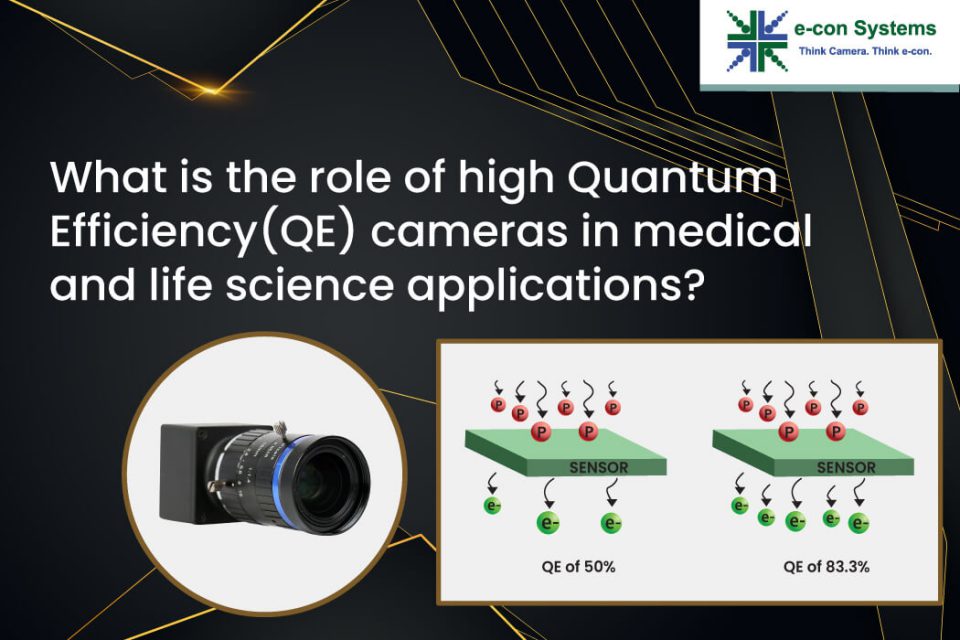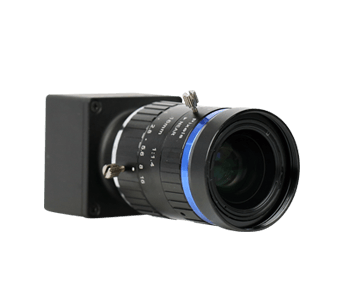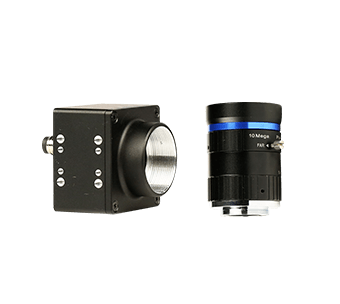QE refers to the ability of a camera to convert incident photons into electrical signals, which is a measure of its sensitivity. High QE (Quantum Efficiency) cameras play a crucial role in medical and life science applications as they allow for improved sensitivity and detection of light. These cameras are essential tools for medical and life science applications that require sensitive detection of light. Hence, high QE cameras are used for a variety of purposes, including imaging of cells and tissues, analysis of fluorescence signals, and detection of biomolecules.
In this article, you will learn in-depth about QE cameras and get specific examples of how high QE cameras are used in the medical and life science industry. You will also unearth information on e-con Systems’ brand-new See3CAM_50CUG, a fixed focus camera with a high QE – based on the Sony Pregius IMX264 CMOS sensor.
What are high QE cameras?
High QE (Quantum Efficiency) cameras are designed to maximize the sensitivity to incoming photons of light. As mentioned earlier, QE is a measure of the efficiency of a camera’s ability to convert photons of light into electrons that can be read out and processed into an image.
So, the sensitivity of a camera is determined by its QE, which is a measure of the fraction of photons that are converted into electrons by the camera’s sensor. A higher QE means that more photons are converted into electrons, resulting in a more sensitive camera.
4 medical and life science use cases of high QE cameras
High QE (Quantum Efficiency) cameras are used extensively in medical and life science applications. They play a critical role in enabling researchers and clinicians to accurately capture and analyze images of biological processes and structures. Some of their use cases include:
- Fluorescence microscopy: High QE cameras are used in fluorescence microscopy to detect and image fluorescently labeled cells and tissues. In fluorescence microscopy, probes or dyes are used to label specific molecules or structures within cells. The probes emit light due to specific wavelengths, which are captured by the camera. High QE cameras are able to detect even very weak fluorescent signals, allowing for accurate imaging and analysis of biological processes at the cellular level.
- Drug discovery: High QE cameras are used in drug discovery applications to image and analyze the activity of potential drug candidates. For instance, these cameras can be used to detect changes within cells – indicating the activity of certain cellular pathways relevant to drug development.
- Digital microscopy: High QE cameras are used in a variety of microscopy applications. For example, they help capture images of living cells and tissues in real-time, allowing for the observation of biological processes as they occur.
- Bioluminescence imaging: High QE cameras are used in bioluminescence imaging, which involves the detection of light emitted by living organisms as a result of natural chemical reactions. So, they can play a crucial role in the detection of cancer cells.
Camera solution for Medical Microscope to Improve the Accuracy & Speed of Diagnosis
Advantages of high QE cameras in medical and life science applications
High QE (Quantum Efficiency) cameras offer several advantages over traditional cameras in medical and life science applications, including:
Improved Signal-to-Noise Ratio (SNR)
High QE cameras have a higher SNR than traditional cameras, which means that the images they produce have less noise or background interference. It results in clearer accurate images – making it simpler to ensure precise analysis of biological processes.
Read More: What is Signal-to-Noise Ratio (SNR)? Why is SNR important in embedded cameras?
Faster image acquisition
High QE cameras can acquire images at a fast rate. It can be a major differentiator for embedded vision applications such as live cell imaging, where it is important to capture changes in real time.
Increased spatial resolution
High QE cameras can capture images with high spatial resolution. This allows for the visualization of fine details in biological samples, such as the structure of individual cells or subcellular organelles.
Compatibility
High QE cameras are compatible with a range of imaging techniques. Their versatility makes them useful tools for a wide range of medical and life science applications.
See3CAM_50CUG – e-con Systems’ latest all-in-one medical and life science camera
e-con Systems has been pioneering several embedded vision breakthroughs in the medical and life science industries. Our latest product is the See3CAM_50CUG – a 5MP high sensitivity fixed focus camera based on the Sony Pregius IMX264 CMOS sensor. Some of its unique features include:
- Back-illuminated pixel technology
- Large sensor with a large pixel size
- Near Infrared (NIR) performance
- High dynamic range
- High sensitivity
- Global shutter
See3CAM_50CUG also comes with a C-mount lens holder and is UVC-compliant for Windows and Linux.
Of course, if you need help integrating camera solutions into your vision-based medical or life science application, we are just an email away. Please write to us at camerasolutions@e-consystems.com. You can also check out our Camera Selector page to see our entire portfolio of cameras.

Balaji is a camera expert with 18+ years of experience in embedded product design, camera solutions, and product development. In e-con Systems, he has built numerous camera solutions in the field of ophthalmology, laboratory equipment, dentistry, assistive technology, dermatology, and more. He has played an integral part in helping many customers build their products by integrating the right vision technology into them.






